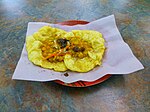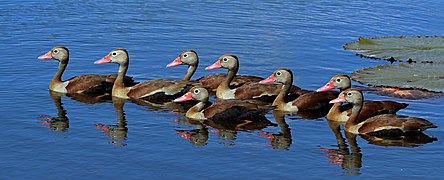Portal:Trinidad and Tobago
Trinidad and Tobago Portal
The Republic of Trinidad and Tobago is a country located at the southern tip of the Caribbean. It borders the countries of Grenada and Venezuela. It was the first Caribbean country to host the Summit of the Americas. It shares maritime boundaries with other nations including Barbados to the northeast, Guyana to the southeast, and Venezuela to the south and west. A treaty between the Republic of Trinidad and Tobago and the Republic of Venezuela on the delimitation of marine and submarine areas, 18 April 1990. The country covers an area of 5,128 square kilometres (1,980 sq mi) and consists of two eponymous main islands, Trinidad and Tobago, and numerous smaller landforms. Trinidad is the larger and more populous of the main islands; Tobago is much smaller, comprising about 6% of the total area and 4% of the entire population which is estimated at 1.3 million (2005). The nation lies outside the hurricane belt. Unlike most of the English-speaking Caribbean, Trinidad and Tobago's economy is primarily industrial with an emphasis on petroleum and petrochemicals. Trinidad and Tobago is well known for its African and Indian cultures, reflected in its large and famous Carnival, Diwali, and Hosay celebrations, as well being the birthplace of steelpan, the limbo, and music styles such as calypso, soca, rapso, parang, chutney, and chutney soca.[1][2][3][4][5][6][7] Selected article -The music of the Lesser Antilles encompasses the music of this chain of small islands making up the eastern and southern portion of the West Indies. Lesser Antillean music is part of the broader category of Caribbean music; much of the folk and popular music is also a part of the Afro-American musical complex, being a mixture of African, European and indigenous American elements. The Lesser Antilles' musical cultures are largely based on the music of African slaves brought by European traders and colonizers. The African musical elements are a hybrid of instruments and styles from numerous West African tribes, while the European slaveholders added their own musics into the mix, as did immigrants from India. In many ways, the Lesser Antilles can be musically divided based on which nation colonized them. The former British colonies include Trinidad and Tobago, whose calypso style is an especially potent part of the music of the other former British colonies, which also share traditions like the Big Drum dance. The French islands of Martinique and Guadeloupe share the popular zouk style and have also had extensive musical contact with the music of Haiti, itself once a French colony though not part of the Lesser Antilles. The Dutch colonies of Curaçao, Bonaire and Aruba share the combined rhythm popular style. The islands also share a passion for kaseko, a genre of Surinamese music; Suriname and its neighbors Guyana and French Guiana share folk and popular styles that are connected enough to the Antilles and other Caribbean islands that both countries are studied in the broader context of Antillean or Caribbean music. (Full article...)CategoriesSelected quoteIn the news
WikiProject
General imagesThe following are images from various Trinidad and Tobago-related articles on Wikipedia. Selected pictureA Tobago one penny postage stamp of 1889
Did you know
Selected cuisine
Doubles is a common street food originating from Trinidad and Tobago. It is normally eaten during breakfast, but is also eaten occasionally during lunch or as a late night snack and popular hangover food for local Trinidadians. Doubles are made with two baras (flat fried dough) and filled with curry channa (curried chickpeas) and various chutneys. Doubles was first created in Fairfield, Princes Town by Emamool Deen (a.k.a. Mamudeen) and his wife Raheman Rasulan Deen in 1936.
Selected panoramaTopicsLists
Select [►] to view subcategories
Recognized content
Featured articlesFeatured listsGood articles
Did you know? articles
Featured pictures
Featured portalsIn the News articles
Main page featured articlesMain page featured listsPicture of the day pictures
Related portalsWikiProjectsTrinidad and Tobago Wikipedians' Notice Board · Trinidad and Tobago Wikipedians
On this dayAssociated WikimediaThe following Wikimedia Foundation sister projects provide more on this subject:
Portal informationThis portal has been maintained by WikiProject Trinidad and Tobago
Discover Wikipedia using portals |
||||||||||||||
- ^ "In Trinidad, Diwali Lights Up Like Christmas". NPR. Archived from the original on 17 February 2020. Retrieved 20 March 2019.
- ^ "Diwali in Trinidad and Tobago". trinidad.us. Archived from the original on 2 March 2019. Retrieved 20 March 2019.
- ^ Ingram, Amy. "What is Chutney Music?". Wesleyan University. Archived from the original on 16 July 2011. Retrieved 10 September 2018.
- ^ "Parang Music". Destination Trinidad and Tobago. Archived from the original on 10 September 2018. Retrieved 10 September 2018.
- ^ "Soca Music History". Artdrum. Archived from the original on 19 September 2018. Retrieved 10 September 2018.
- ^ "A brief history of the steel pan". BBC. 24 July 2012.
- ^ "Trinidad Carnival for Beginners". Caribbean Beat. 1 January 1993. Archived from the original on 8 April 2018. Retrieved 10 September 2018.
































































